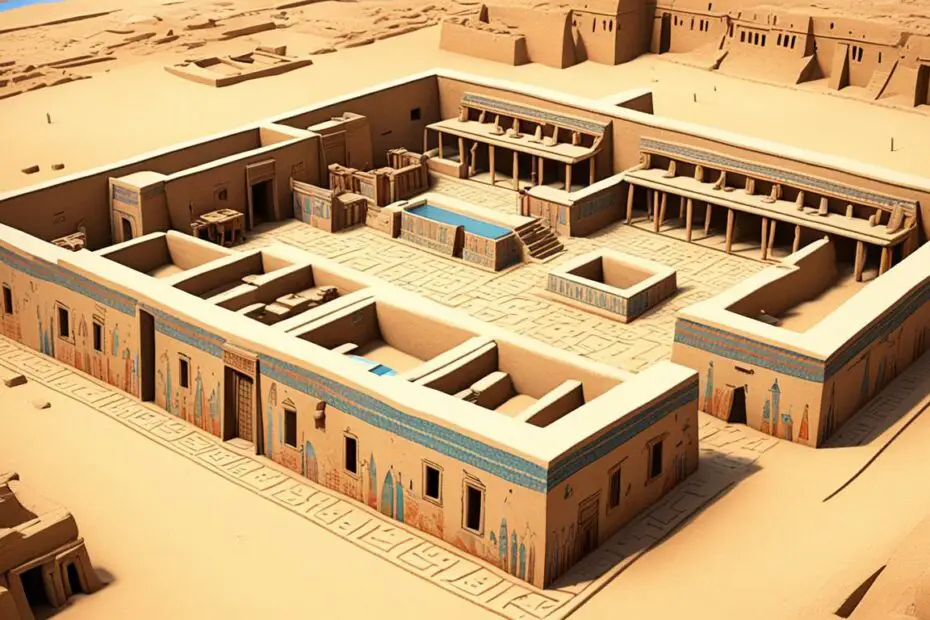Have you ever wondered what the homes of ancient Egyptians looked like? How were they designed and what materials were used in their construction? Unravel the mysteries of ancient Egyptian homes as we delve into the fascinating world of Nile Valley home design.
Ancient Egyptian homes, nestled along the banks of the majestic Nile River, were a testament to the ingenuity and artistry of this ancient civilization. From the humble abodes of ordinary Egyptians to the opulent residences of the elite, each dwelling reflected the unique social dynamics and cultural values of the time.
Join us on a journey back in time as we explore the architecture, layout, and intricacies of ancient Egyptian homes. Discover how these structures played a vital role in shaping the daily lives, traditions, and aspirations of the people.
Step into the world of the Pharaohs and witness the wonders of ancient Egyptian home design. Prepare to be captivated by the remarkable tales these ancient dwellings have to tell.
Mayan Homes: From Ordinary to Elite
During the ancient Mayan Empire, the Mayan civilization developed unique architectural styles that were reflected in their homes. Mayan homes were constructed using locally available materials such as wood, straw, and baked mud. Whether belonging to ordinary people or the elite, Mayan homes showcased the ingenuity and creativity of the Mayan civilization.
The ordinary Mayan homes were oval in shape with thatched roofs. These simple dwellings provided shelter and a place for daily activities. In contrast, the homes of the Mayan elite were more sophisticated and luxurious. They boasted multiple rooms and fine furniture, symbolizing the wealth and status of their occupants. The intricate design and thoughtful craftsmanship of these elite homes demonstrated the meticulous attention to detail that the Mayan civilization was known for.
However, the epitome of grandeur in Mayan architecture lay in the palaces of the Mayan Empire. These palaces were extravagant in every sense, adorned with elaborate stone and stucco decoration. They served as the epitome of power and authority, showcasing the wealth and influence of the rulers.
Visualizing Mayan Homes
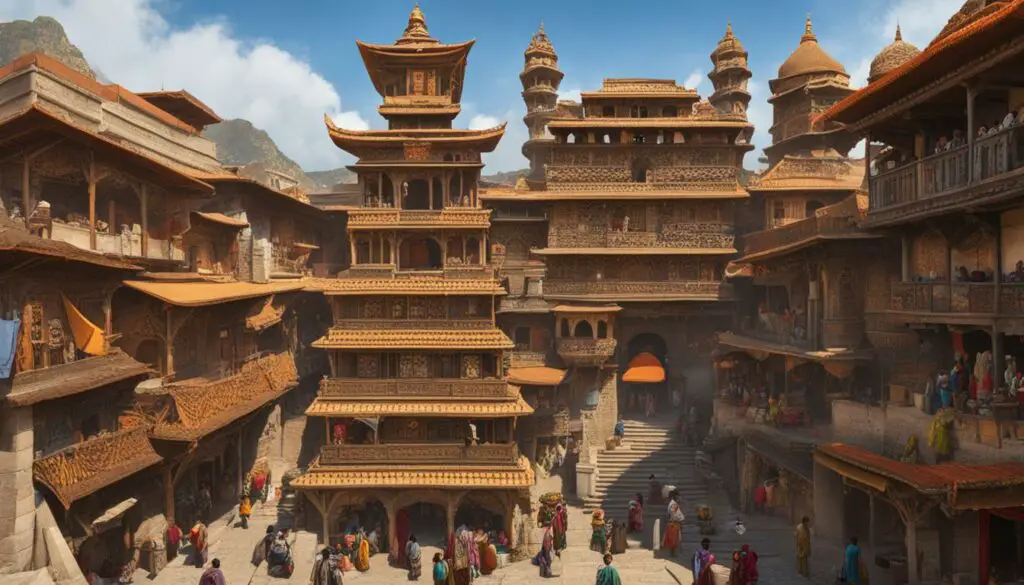
The image above captures the essence of Mayan homes with its unique architectural features. The thatched roof, oval shape, and wooden construction represent the ordinary Mayan homes, while the grandeur and exquisite detailing resemble the palaces of the Mayan Empire. This image allows us to visualize the stark contrasts between the dwellings of the ordinary Mayans and the opulence of the ruling elite.
Mesopotamian Dwellings: From Ordinary to Elite
The homes of ancient Mesopotamians showcased their ingenuity and resourcefulness. Crafted from plaited reeds and mud bricks, these dwellings reflected the unique aspects of Mesopotamian culture and architecture.
The homes of ordinary Mesopotamians featured entrances at each end and were designed with separate spaces for living, guest accommodations, and even livestock. They were functional and practical, meeting the everyday needs of the inhabitants.
On the other hand, the elite homes were grander and constructed from whitewashed mud bricks or limestone. These residences showcased the wealth and status of the elite class. They often had separate bedrooms, luxuries like plumbed toilets, and elaborate furniture. The elite Mesopotamian homes were not only comfortable but also represented the opulence of the ruling class.
A Comparison of Mesopotamian Homes:
| Ordinary Mesopotamian Homes | Elite Mesopotamian Homes | |
|---|---|---|
| Materials | Plaited reeds and mud bricks | Whitewashed mud bricks or limestone |
| Design | Entrances at each end, separate spaces for living and guest accommodations or livestock | Separate bedrooms, plumbed toilets, elaborate furniture |
| Size | Varied depending on the needs of the family | Generally larger and more spacious |
| Decoration | Simpler, focusing on functionality | Sometimes adorned with intricate designs and motifs |
The construction of these homes played a vital role in shaping the Mesopotamian way of life. They provided comfortable living spaces, while also reflecting the social hierarchies and aspirations of the ancient Mesopotamians.
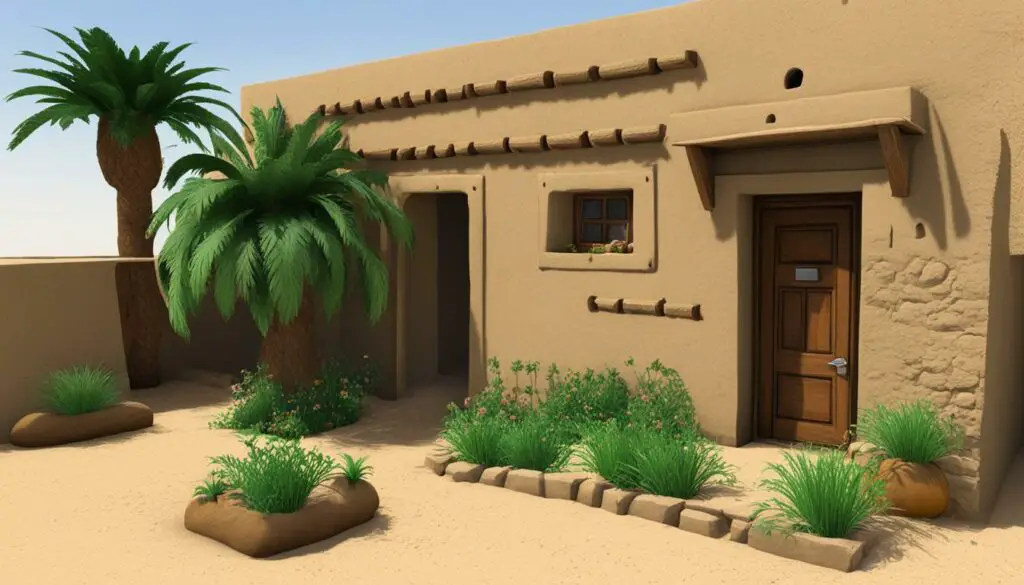
Ancient Egyptian Dwellings: From Ordinary to Elite
Homes in Ancient Egypt were constructed using the abundant resources found in the River Nile region. The architecture of ancient Egypt was influenced by both the availability of materials and the need for protection from the intense heat of the Egyptian climate.
Ancient Egyptian homes showcased a range of designs and features, catering to the diverse social classes of the time. While the houses of ordinary Egyptians were simple one-room abodes, the homes of the elite were significantly more elaborate with multiple rooms and luxurious amenities.
The typical ancient Egyptian home, regardless of social status, was made of mud bricks. These bricks were crafted from mud obtained from the River Nile and dried in the sun. Papyrus, a plant that grew abundantly in the region, was also used in construction, particularly for making roofs.
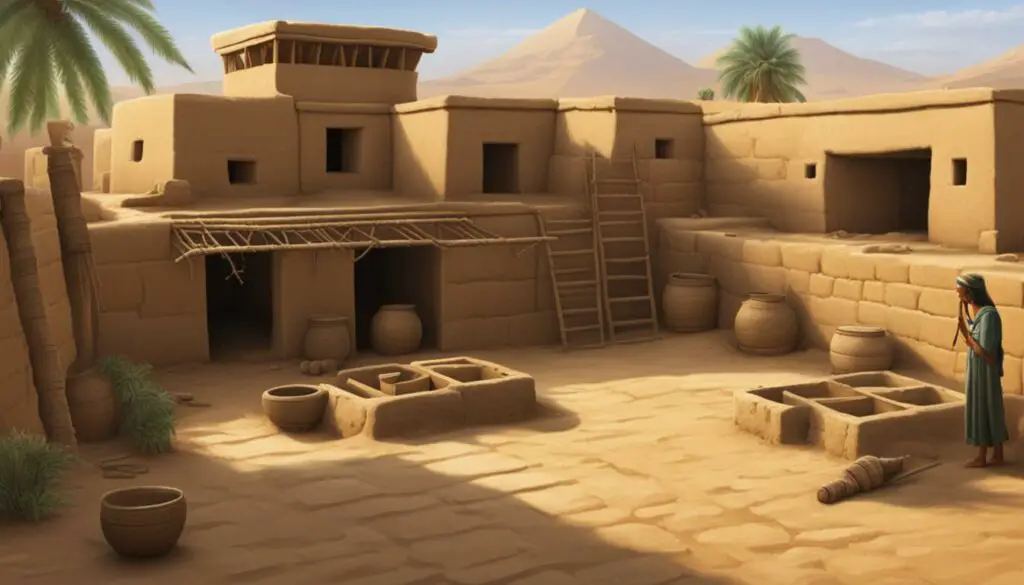
Ordinary Egyptian Homes
The houses of ordinary Egyptians consisted of one main room with a flat roof. These simple dwellings were often suffused with natural light, thanks to small openings in the walls called air vents. The floors were made of compacted earth, providing a cool surface during the scorching summers.
While these homes lacked the grandeur of the elite residences, they still served as the center of family life, where daily routines and social interactions took place.
Elite Egyptian Homes
The homes of the elite, such as nobles, government officials, and priests, were more spacious and adorned with finer materials. These elite homes were often crafted from whitewashed mud bricks or limestone, giving them a more distinguished appearance.
The residences of the elite showcased architectural sophistication and included multiple rooms for different purposes. Apart from the main living quarters, elite homes featured separate spaces for toilets, large kitchens, guest rooms, and even private gardens.
Table: Features of Ordinary and Elite Ancient Egyptian Homes
| Features | Ordinary Egyptian Homes | Elite Egyptian Homes |
|---|---|---|
| Number of Rooms | One main room | Multiple rooms |
| Materials | Mud bricks and papyrus | Whitewashed mud bricks or limestone |
| Amenities | Basic facilities | Separate toilets, large kitchens, guest rooms, private gardens |
Ancient Egyptian homes, from the ordinary to the elite, reflected the society’s social hierarchy and economic prosperity. The architecture of these dwellings, combined with the practical use of locally-available materials, shaped the unique style of homes in ancient Egypt.
Minoan Residences: From Ordinary to Elite
The Minoan culture flourished in ancient Europe, specifically on the island of Crete and the surrounding Aegean islands. The Minoans were known for their advanced civilization and architectural achievements, which can be seen in their impressive residences.
The ordinary Minoan homes were fairly large rectangular duplex houses made from stone. These homes provided comfortable living spaces for ordinary Minoans and showcased their knowledge of construction techniques. The use of stone as a building material ensured durability and longevity, allowing these homes to withstand the test of time.
On the other hand, the elite Minoan homes were elaborate palaces with capacious rooms and courtyards. These palaces were the residences of the ruling elite and displayed their wealth and power. The Minoan palaces were architectural marvels, featuring complex layouts, multi-story structures, and impressive frescoes adorning the walls.
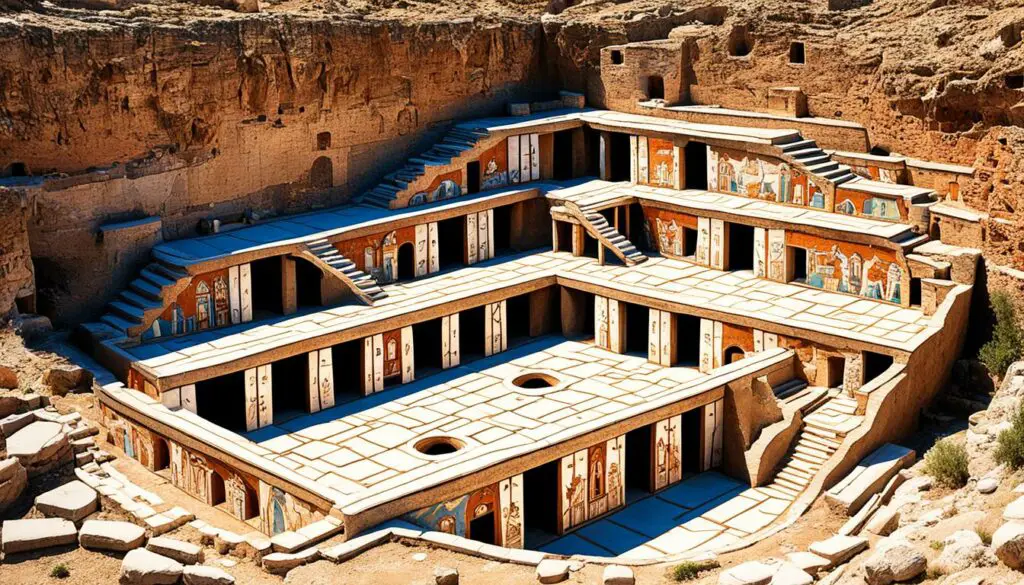
The vibrant murals found in these palaces were a testament to the Minoan appreciation for aesthetics and artistic skills. These intricately painted wall decorations depicted scenes of nature, religious ceremonies, and daily life, offering insights into the Minoan culture and society.
The Minoan residences, both ordinary and elite, reflect the ingenuity and sophistication of the ancient Minoans. Their architectural choices, use of quality materials, and attention to decorative details demonstrate the far-reaching influence of Minoan culture in the ancient world.
| Minoan Residences | Features |
|---|---|
| Ordinary Homes | Fairly large rectangular duplex houses made from stone |
| Elite Palaces | Elaborate palaces with capacious rooms and courtyards adorned with vibrant murals |
Iron Age Britons: Homes in Ancient Britain
The Iron Age in Britain marked a significant period of change, characterized by the introduction of iron technology and a substantial increase in population. The homes of Iron Age Britons, reflecting the cultural influences of Celtic society, exhibited a variety of sizes and designs. One prominent type of dwelling was the roundhouse, a circular structure constructed using branches and thatch.
These roundhouses, though relatively modest, served as the foundation for daily life, providing shelter and a space for routine activities. In addition to the roundhouses, the wealthier Iron Age Britons constructed larger farmhouses, villas, and palaces, showcasing their social status and affluence through grander architecture.
The ancient British homes, be it the humble roundhouse or the opulent villa, exemplified the craftsmanship and resourcefulness of the Iron Age Britons. These dwellings stood as testaments to their ability to adapt to their environment and utilize available materials in ingenious ways. Moreover, they reflected the strong sense of community and connection to the land that characterized Celtic culture during this era.
FAQ
Q: What materials were ancient Egyptian houses made from?
A: Ancient Egyptian houses were constructed using mud bricks and papyrus.
Q: How did the design of ancient Egyptian houses vary?
A: The design of ancient Egyptian houses varied based on the social status and wealth of the occupants. Ordinary Egyptians lived in simple one-room abodes, while the homes of the elite were more spacious and adorned with finer materials.
Q: What was the purpose of ancient Egyptian houses?
A: Ancient Egyptian houses served as centers for family life, social interactions, and economic activities. They reflected and reinforced social hierarchies.
Q: What materials were Mayan homes in the ancient Mayan Empire made from?
A: Mayan homes were constructed from wood, straw, and baked mud.
Q: How did Mayan homes differ between ordinary people and the elite?
A: Ordinary people in the Mayan Empire lived in oval homes with thatched roofs, while the homes of the elite had multiple rooms and fine furniture.
Q: What distinguished the palaces of the Mayan Empire?
A: The palaces of the Mayan Empire were especially extravagant, adorned with elaborate stone and stucco decoration.
Q: What were homes in ancient Mesopotamia made from?
A: Homes in ancient Mesopotamia were crafted from plaited reeds and mud bricks.
Q: How did the homes of ordinary Mesopotamians differ from the elite?
A: Ordinary Mesopotamian homes had entrances at each end and contained separate spaces for living and guest accommodations or livestock, while elite homes were grander and often made from whitewashed mud bricks or limestone.
Q: What amenities did elite Mesopotamian homes have?
A: Elite Mesopotamian homes often had separate bedrooms, luxuries like plumbed toilets, and elaborate furniture.
Q: What were ancient Egyptian homes made from?
A: Ancient Egyptian homes were constructed from mud bricks and papyrus, with beaten earth floors and flat roofs.
Q: How did the homes of ordinary Egyptians differ from the elite?
A: Ordinary Egyptians lived in simple one-room abodes, while the homes of the elite were more elaborate with multiple rooms and amenities like separate toilets, large kitchens, and guest rooms.
Q: How did the architecture of ancient Egypt reflect the climate?
A: The architecture of ancient Egypt was influenced by the availability of materials and the need for protection from the intense heat of the Egyptian climate.
Q: What were Minoan homes in ancient Europe made from?
A: Minoan homes in ancient Europe were made from stone.
Q: How did the homes of ordinary Minoans differ from the elite?
A: Ordinary Minoan homes were fairly large rectangular duplex houses, while elite homes were elaborate palaces with capacious rooms and courtyards.
Q: How were the walls of Minoan homes decorated?
A: The walls of Minoan homes were decorated with vibrant murals, showcasing the artistic skills and appreciation for aesthetics in Minoan society.
Q: What materials were homes in ancient Britain made from during the Iron Age?
A: Homes in ancient Britain during the Iron Age were made from branches and thatch.
Q: How did the homes of Iron Age Britons vary in size and design?
A: Iron Age Britons had varied homes, with roundhouses being a common type. The farmhouses, villas, and palaces of the wealthy were built on a grander scale.
Q: What did the homes of Iron Age Britons reflect?
A: The homes of Iron Age Britons reflected their culture and craftsmanship, providing shelter and a place for daily routines.
